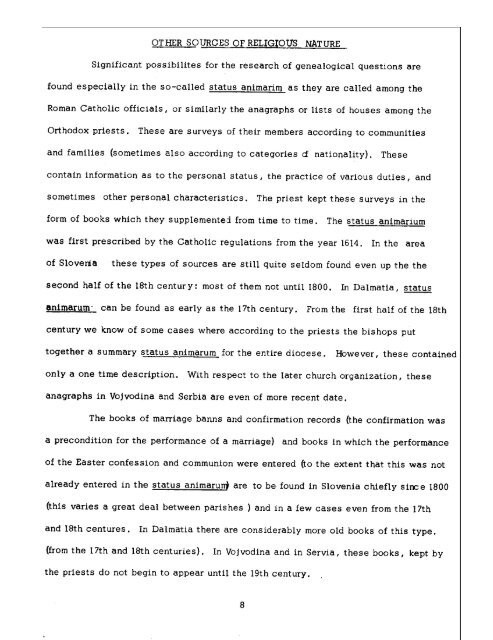Yugoslavia
Yugoslavia
Yugoslavia
You also want an ePaper? Increase the reach of your titles
YUMPU automatically turns print PDFs into web optimized ePapers that Google loves.
OTHER SOURCES OF RELIGIOUS NATURE<br />
Significant possibilites for the research of genealogical questions are<br />
found especially in the so-called status animarim as they are called among the<br />
Roman Catholic officials, or similarly the anagraphs or lists of houses among the<br />
Orthodox priests. These are surveys of their members according to communities<br />
and families (sometimes also according to categories cf nationality). These<br />
contain information as to the personal status, the practice of various duties, and<br />
sometimes other personal characteristics. The priest kept these surveys in the<br />
form of books which they supplemented from time to time. The status animarium<br />
was first prescribed by the Catholic regulations from the year 1614. In the area<br />
of Siovena these types of sources are still quite seldom found even up the the<br />
second half of the 18th century: most of them not until 1800. In Dalmatia, status<br />
animarum' can be found as early as the 17th century. From the first half of the 18th<br />
century we know of some cases where according to the priests the bishops put<br />
together a summary status animarum for the entire diocese. However, these contained<br />
only a one time description. With respect to the later church organization, these<br />
anagraphs in VoJvodina and Serbia are even of more recent date.<br />
The books of marriage banns and confirmation records (the confirmation was<br />
a precondition for the performance of a marriage) and books in which the performance<br />
of the Easter confession and communion were entered (to the extent that this was not<br />
already entered in the status animarun) are to be found in Slovenia chiefly sin::: e 1800<br />
(this varies a great deal between parishes) and in a few cases even from the 17th<br />
and 18th centures. In Dalmatia there are considerably more old books of this type.<br />
(from the 17th and 18th centuries). In VoJvodina and in Servia, these books, kept by<br />
the priests do not begin to appear until the 19th century.<br />
8


